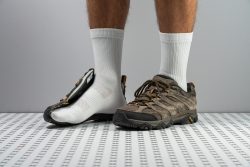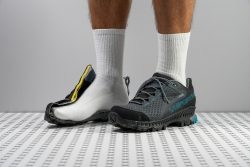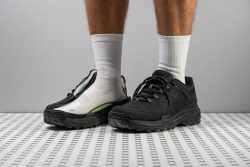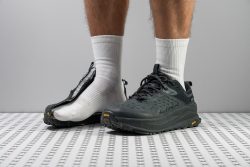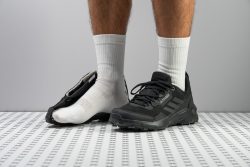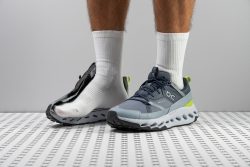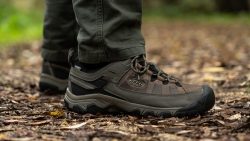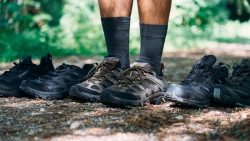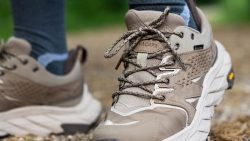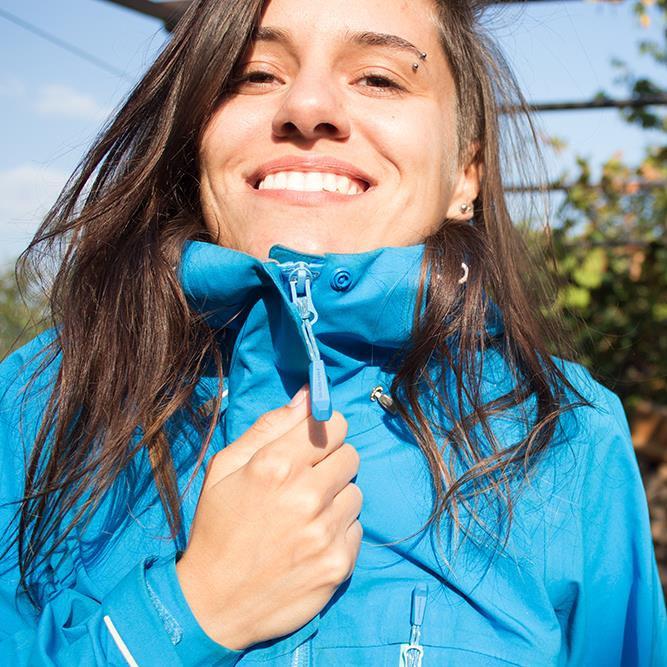6 Best Flat Feet Hiking Shoes in 2025
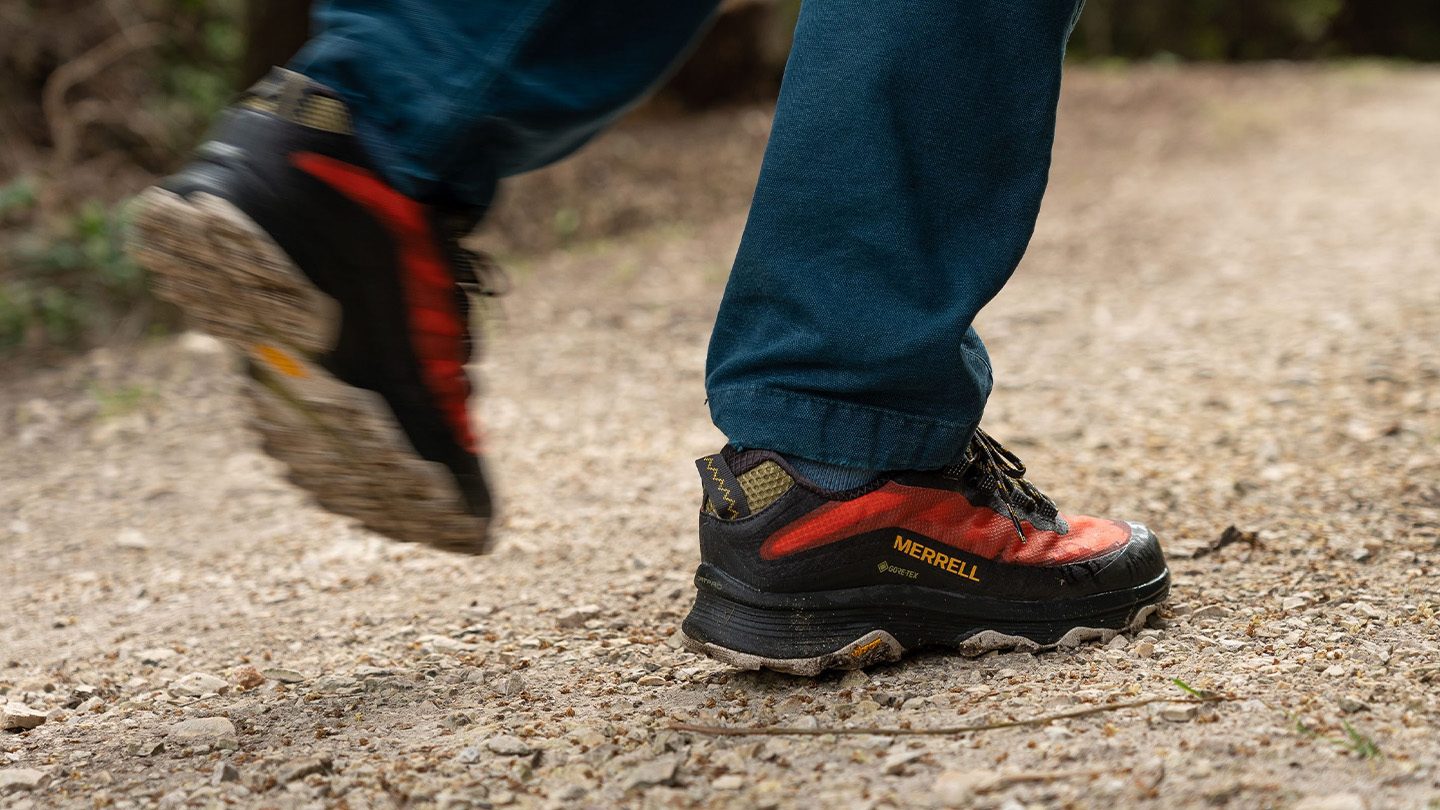
We buy shoes ourselves. We earn commissions when you buy through us, at no extra cost. Why trust us
Flat feet can be a burden but they don't have to be. Working with a specialist on diagnosis, strengthening the foot and leg muscles, and wearing supportive and stable hiking shoes can do wonders. In this guide, we explain all the hiking shoe features relevant for flat feet, how to recognize them, and why they are important, and we showcase our lab data for all the shoes we've tested.
In case you want to keep things short, look at our top picks in different categories. These hiking shoes outperformed the rest both on our test hikes and in the lab.
How we test flat feet hiking shoes
To keep our testing process as objective as possible, we buy all the hiking shoes with our own money. We have no contracts with the brands and no tester on our team is a brand ambassador. This allows us to publish everything we notice and discover on our test hikes and in the lab.
Our process is made of these steps:
- Buying the shoes with our own money
- Testing the hiking shoes on the trails, in different weather conditions, and covering various terrain, from well-maintained trails to obstacle-covered single tracks, mud, rocks, etc.
- Testing the shoes in the lab, where we quantitatively describe each shoe with over 20 data points thanks to our standardized tests
- Publishing everything on our website, where you can compare the hiking shoes by features of interest or to the average to get an idea of how the shoe performs overall.
Best hiking shoes for flat feet overall
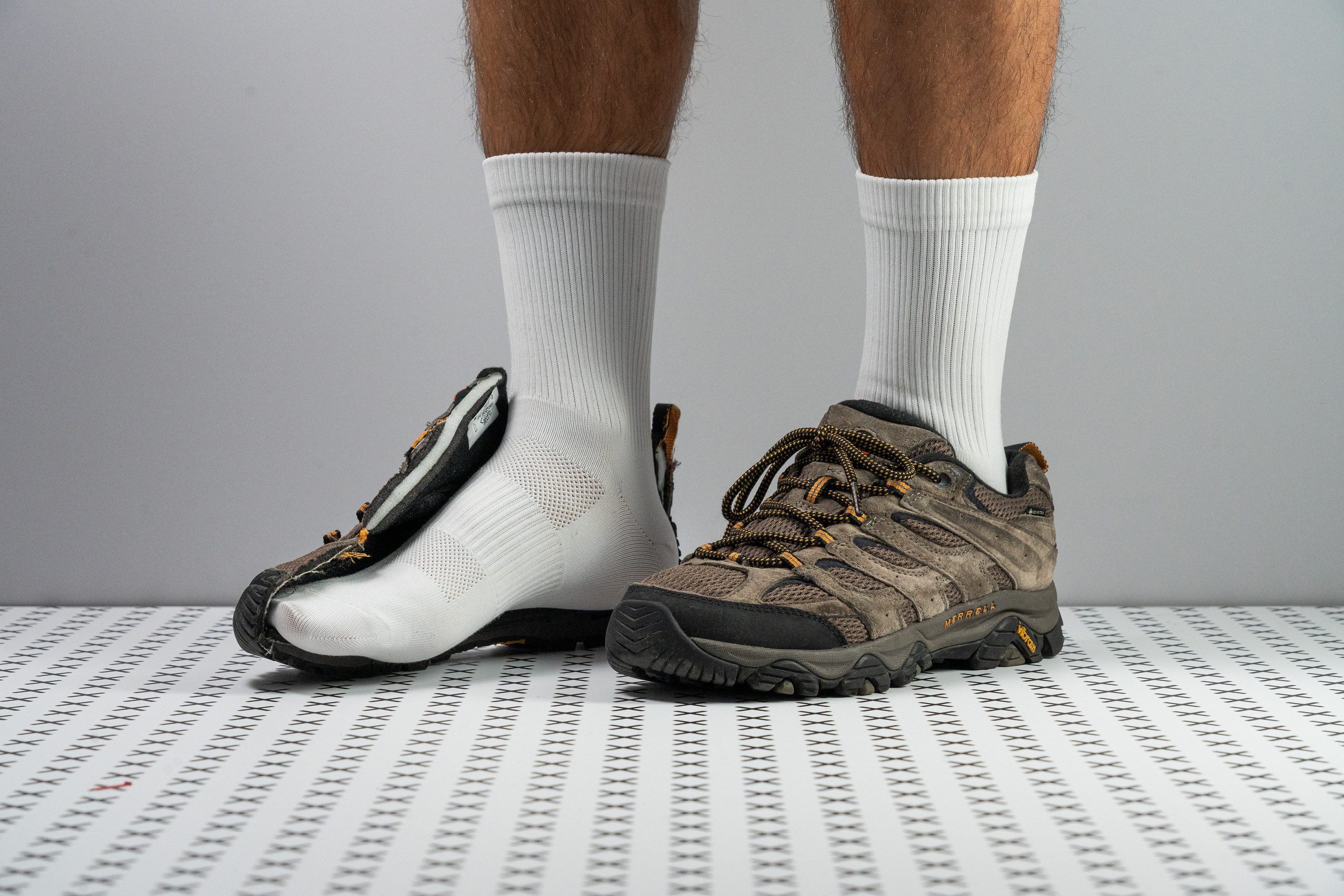

































What makes it the best?
Demanding trails felt like a breeze as we tested the Merrell Moab 3 GTX on foot. It has a flexible build yet feels exceptionally stable because of its sturdy features and unwavering traction that we discovered in the lab. With its solid mix of agility and support, it’s our best flat-feet hiking shoe.
The midsole kept us secure even as we were loaded with backpacks. A nylon shank stabilizes the midfoot and heel areas. Moab 3 GTX holds our feet firmly in place with its stiff heel counter without too much discomfort, proven by its 4/5 stiffness rating.
Comfort is enhanced through its bendable midsole, which we recorded to be 16.9% more flexible than average in our lab test. We like how we don’t have to fight much resistance to move and adapt through the trails.
Another feature that kept our hikes steady was the grippy Vibram outsole. It has deep 4.8 mm lugs that kept us surefooted even on loose dirt and wet grass. We were so confident with its traction that we could climb and descend with smooth control.
A tiny nitpick is that the round shoelaces easily come undone, so we recommend replacing or double-tying them.
Pros
- Superb day-one comfort
- Brilliant surface adhesion
- Supportive like a work shoe
- Remarkably durable
- A-grade waterproofing
- Sheds mud quite well
- Protective toe box
- Incredible overall quality
Cons
- Heavy for a low-top
- Subpar breathability
- Its shoelaces unravel often
- Minimal shock absorption
Best backpacking shoes for flat feet
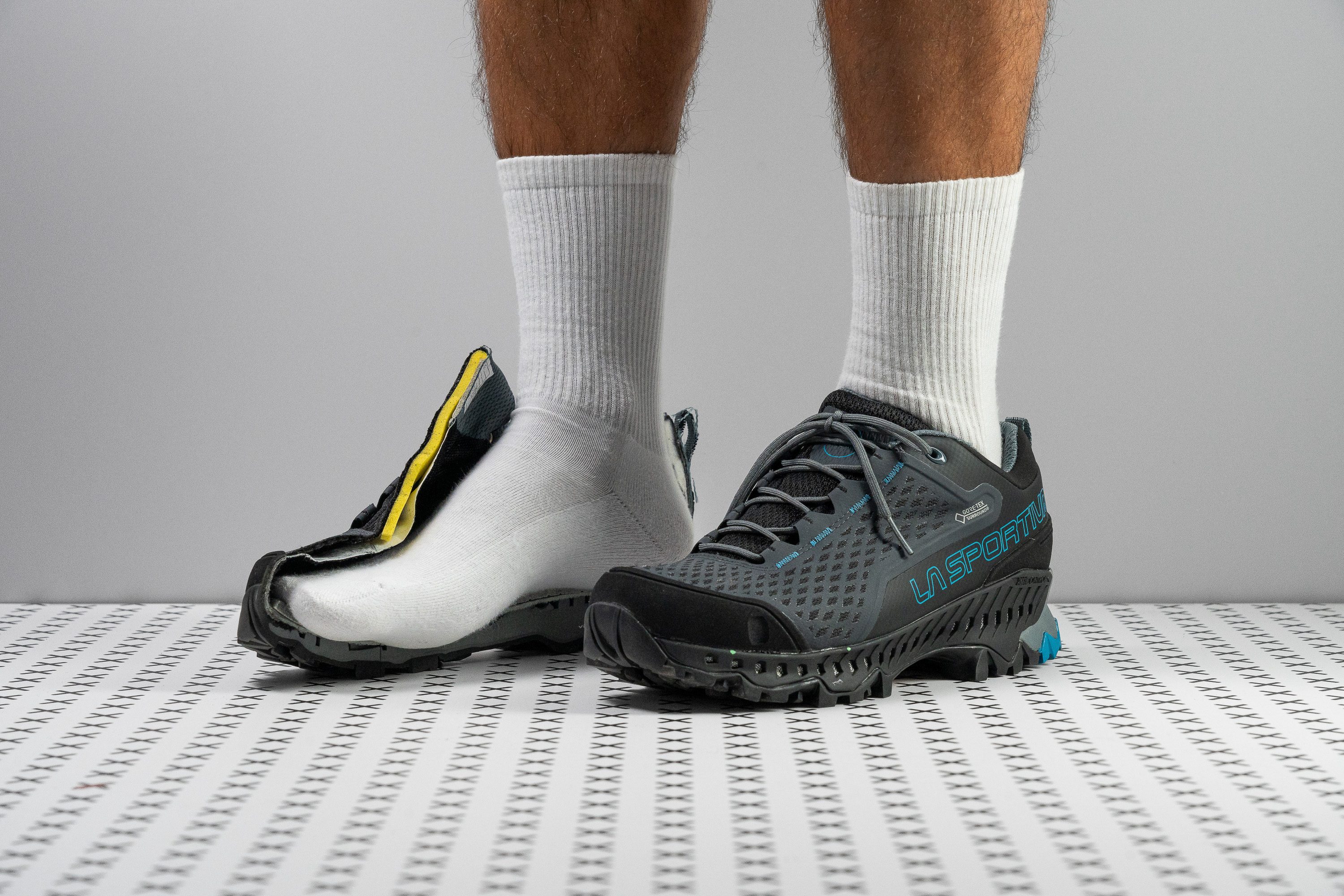





















































What makes it the best?
Serving boot-like protection, the La Sportiva Spire GTX delivers exceptional support and waterproofing in our treks, keeping our feet safe from ankle rolls and various outdoor elements. Lab tests show its thick stack keeps us isolated from the ground while its sturdy construction and steep drop create a stable setup for carrying heavy loads. Therefore, it’s our best backpacking flat-feet hiking shoe.
With its massive 39.1 mm heel, it erases even the sharpest rocks we accidentally step on. It’s paired with a moderate 23.1 mm forefoot, creating a steep 16.0 mm drop that takes the load off our ankles and Achilles. This feels less taxing on our lower-leg muscles, especially during long hikes.
Its STB Control System with sturdy sidewalls cradles our feet, ensuring proper foot alignment. It results in increased torsional rigidity, proven by its 4/5 rating in our assessment, and forms a highly stable ride.
Besides the Gore-Tex membrane in the upper, it has synthetic overlays that protect us from cold and moisture. In our smoke test, the air couldn’t escape, so we gave it a 1/5 breathability score. It delivers effective waterproofing, which we experienced as we encountered rain and puddles in our hikes.
However, all its support comes at a premium cost of $209. Those who are not willing to spend 47.2% above the average hiking shoe should check cheaper alternatives.
Pros
- Feels like a backpacking boot with low collar
- Unparalleled stability and support
- Superb waterproofness with some breathabilty
- Mutes out rocks and debris like no other
- Excellent grip and braking
- Sturdy and durable construction
- Greater range of sizes allows to fine tune the fit
Cons
- Can feel tippy on rocky and hilly terrain
- Frail inner lining
- Gets even firmer in cold
Best hiking shoes for flat feet and plantar fasciitis
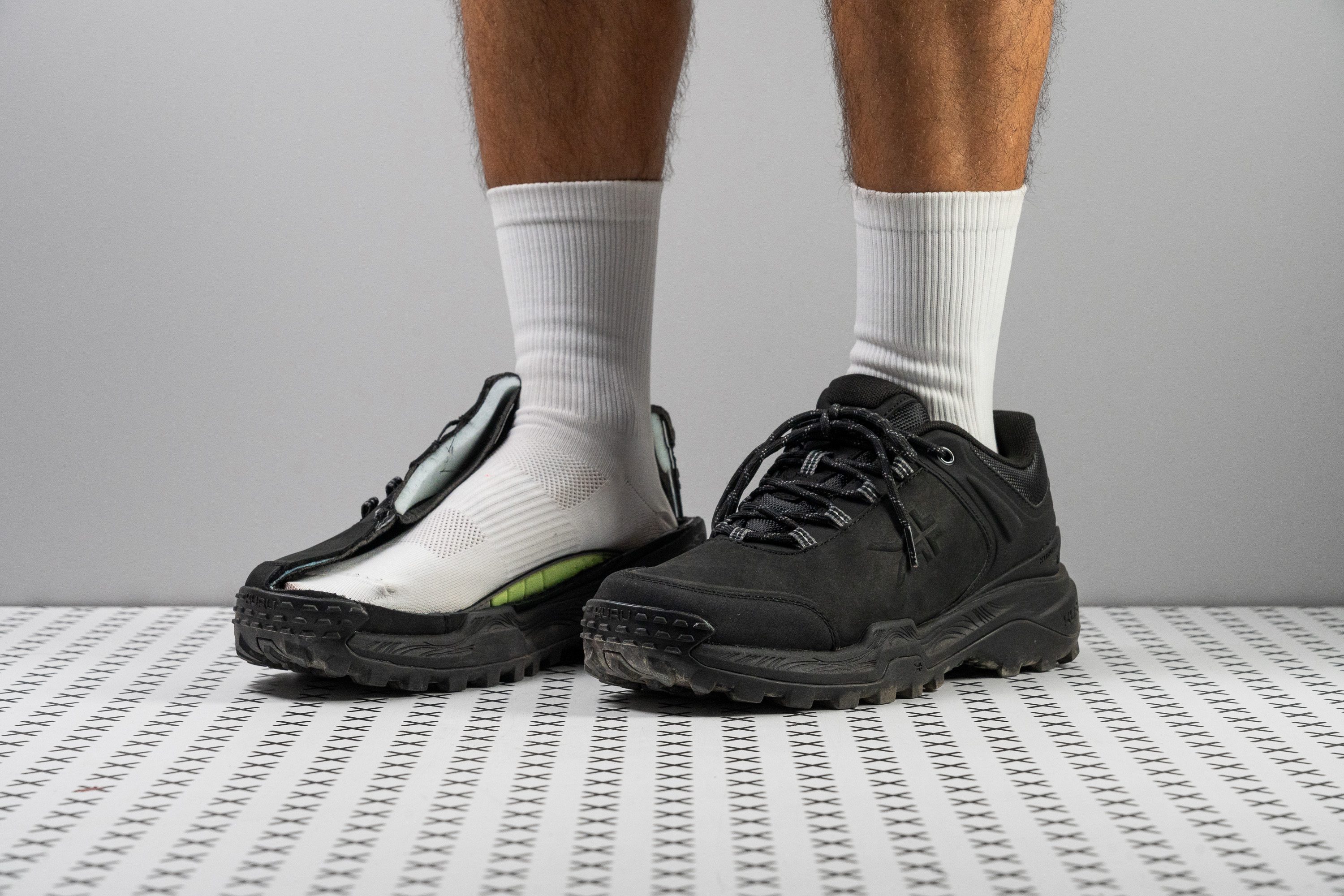










































What makes it the best?
The KURU Ride Motion is so protective that during our trial sessions, it had us questioning why it has the word motion in its name. Our lab tests show that, from its proprietary KURUSOLE and rigid construction to its steep drop, its main purpose is to avoid excessive movement and any additional foot pain. It’s undoubtedly our best flat-foot hiking shoe for those with plantar fasciitis.
The midsole erased harsh debris underfoot, and our caliper confirms a 38.6/26.5 mm chunk of foam separating us from the ground. With its steep 12.1 mm drop, it puts less strain on our heels and allows us to walk longer. Plus, the patented KURUSOLE is an added heel pad that supports our feet.
The shoe is made of leather, which controls excessive lateral movements. Because of this, we couldn’t rate its torsional rigidity lower than 5/5. On foot, it felt impossible to twist our ankles and lose our balance.
The toothy 3.7 mm lugs enhanced the shoe’s grip. Testing for its traction in our wet-condition test, it returned a solid 0.58 rating, confirming its effectiveness.
However, this shoe’s heavy weight may feel burdensome for other hikers. At 16.2 oz (458g), it’s 20.5% above the average hiking shoe! Those seeking a lighter pair should check alternatives.
Pros
- Orthopedic foot support
- Comfortable in-shoe experience
- True to medium width
- Excellent grip on varied terrain
- Fantastic lateral stability
- Tough nubuck leather upper
Cons
- Only moderate shock absorption
- Heavier than average
- Outsole and inner lining lack durability
Best hiking shoes with a wide toebox
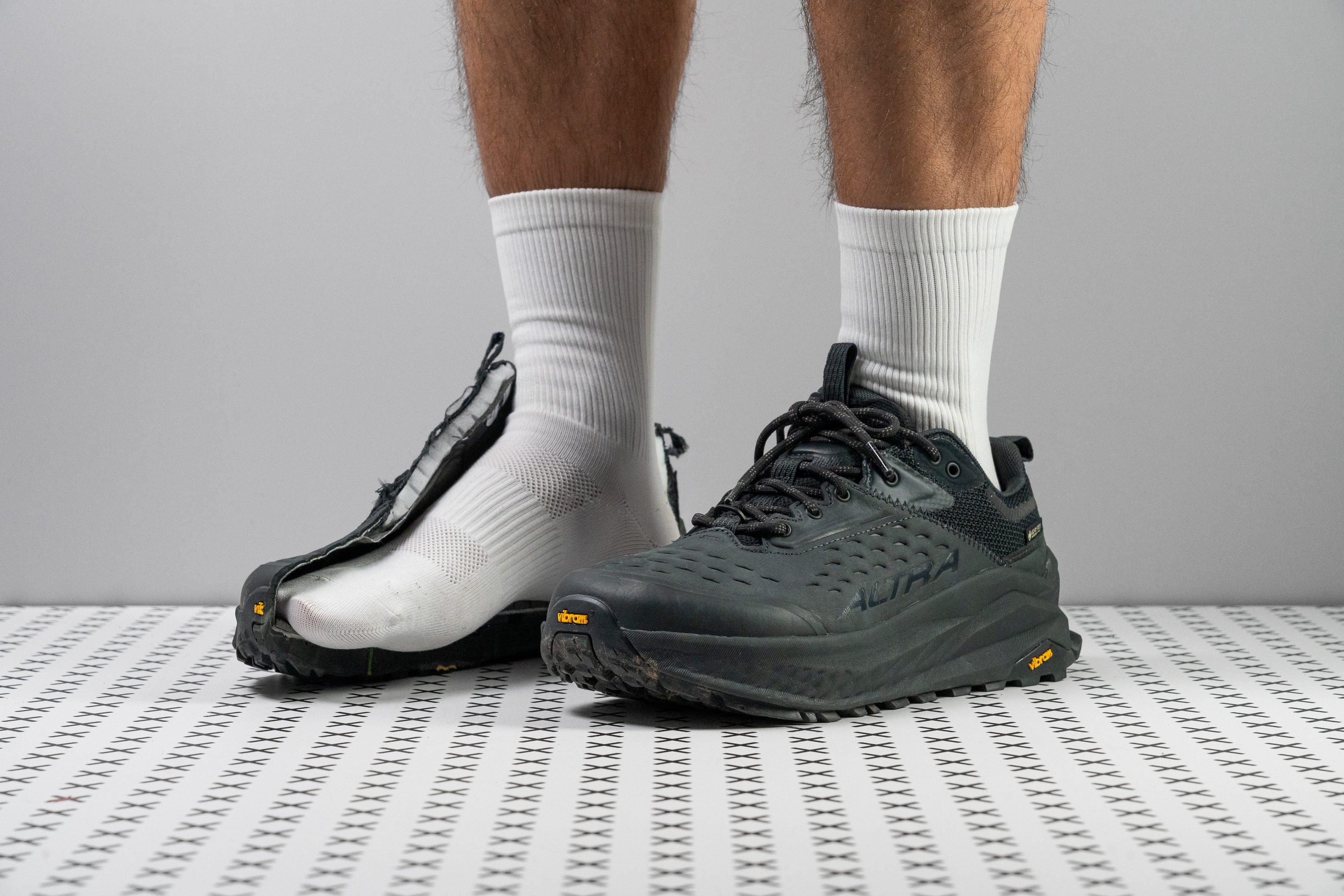
















































What makes it the best?
The Altra Olympus 6 Hike Low GTX does wonders in keeping our feet happy and supported during our hikes. We confirmed in the lab that it offers a very accommodating fit, while its stiff and wide midsole and grippy outsole enhance stability. Therefore, it’s our top hiking shoe for flat and wide feet.
Even those of us with broad feet had no pressure points, even if we wore thick socks, since the roomy silhouette let us move freely. We created a one-to-one gel mold to measure the interiors precisely, and were blown away by its massive 99.9 mm width. For context, this is the widest we’ve seen, and the average is only at 94.1 mm.
The base also has extended dimensions, leaving no room for losing our balance. Our caliper shows it’s indeed wide at 117.2/101.3 mm, which naturally enhances a well-planted sensation. On top of that, the heel counter holds us firmly with its 4/5 rating, while the midsole has no give to twisting at all with its 5/5 torsional rigidity rating.
The grippy base adds to our confidence and control. In our wet-condition test, it shows strong traction at 0.49, promising a slip-free experience.
However, its generous dimensions brought its weight down to 14.4 oz (408g). Those who prefer lightweight and agile should go for another pair.
Pros
- Excellent shock absorption
- Comfortably soft cushioning
- Ultra padded and cozy step-in feel
- Exceptionally wide fit and footshaped toebox
- Extra wide and stable platform
- Highly durable leather and outsole
- Excellent grip on smooth and wet rocks
- Solid waterproofing
Cons
- Not a true zero-drop (1.5 mm)
- Midsole gets notably firmer in cold
- Frail inner lining
Best budget hiking shoes for flat feet
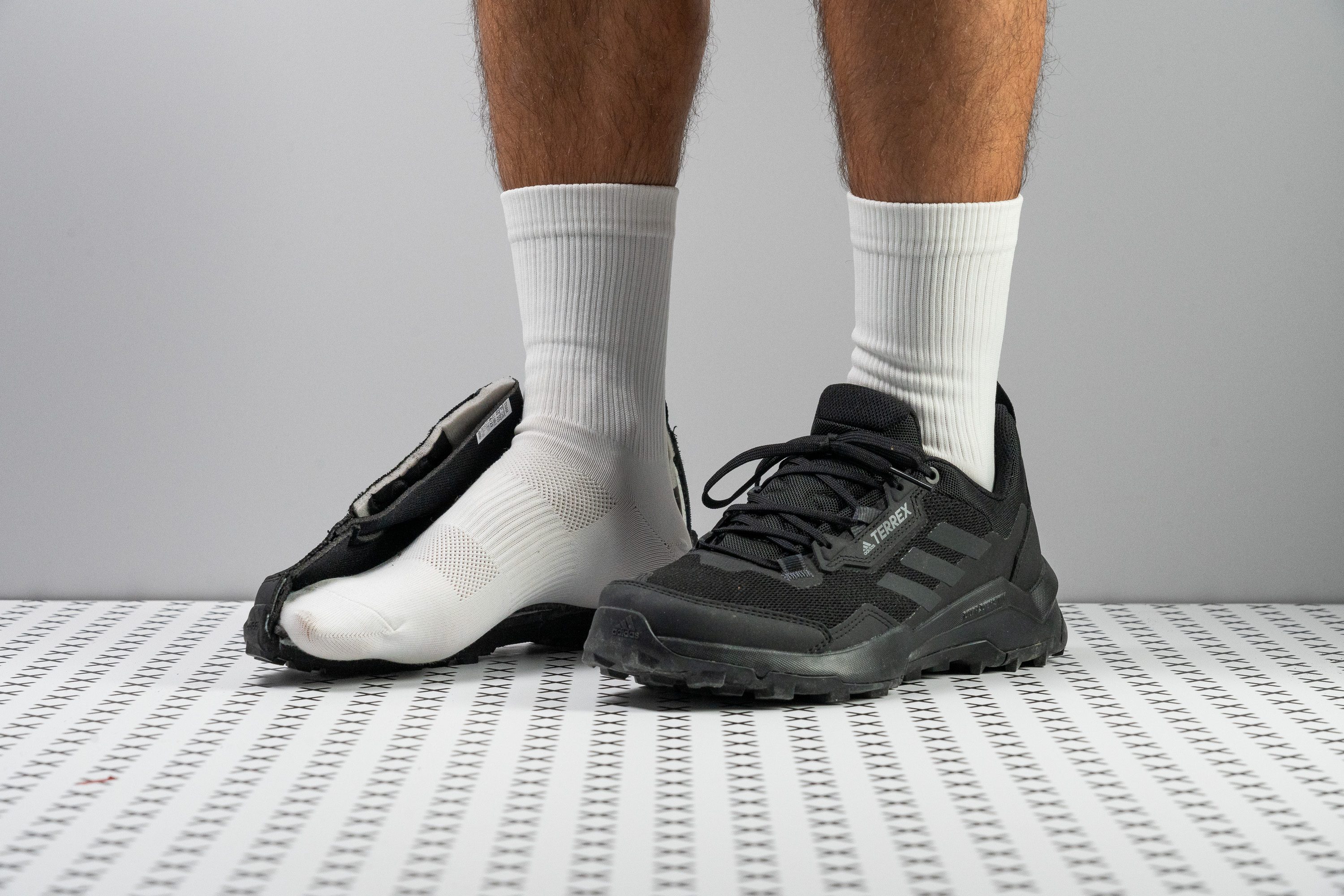






































What makes it the best?
While the average hiking shoe costs $142, we’re surprised that there’s a $90 shoe available in the market: the Adidas Terrex AX4! Both our trail sessions and lab results can confirm its protective nature through its water-repellant upper, reliable traction, and firm base. For all these and more, it’s our best budget hiking shoe for flat feet.
The Terrex AX4 provides impressive resistance to light rain and wet grass. It has water-repellant capacities while allowing for some nice airflow, evidenced by its 3/5 breathability score in our smoke test. We enjoyed the protection it brings without suffocating our feet with body heat.
Even as we tackled wet surfaces, the grippy base gave us the confidence to hike without thinking too much. We measured the chevron lugs to be 3.7 mm deep, while a heel brake was present to assist us during downhill trails.
The Terrex AX4 feels very stable and we discovered two main contributing factors in the lab. First, the foam is 40.8% firmer than average, avoiding any unwanted compressions. Second, the base is wide enough to help us find our footing.
However, the toebox space is more cramped than usual. We recommend those with wide or voluminous feet to size up or check more accommodating shoes.
Pros
- Excellent value for money
- Feels like a trail running shoe
- Breathable
- Water-repellent
- Excellent grip
- Durable for the price
- Stable platform
- Contains recycled materials
Cons
- Lacks toe protection
- Flimsy insole
- Aggressively tapered toebox
Best city-to-trail hiking shoes for flat feet
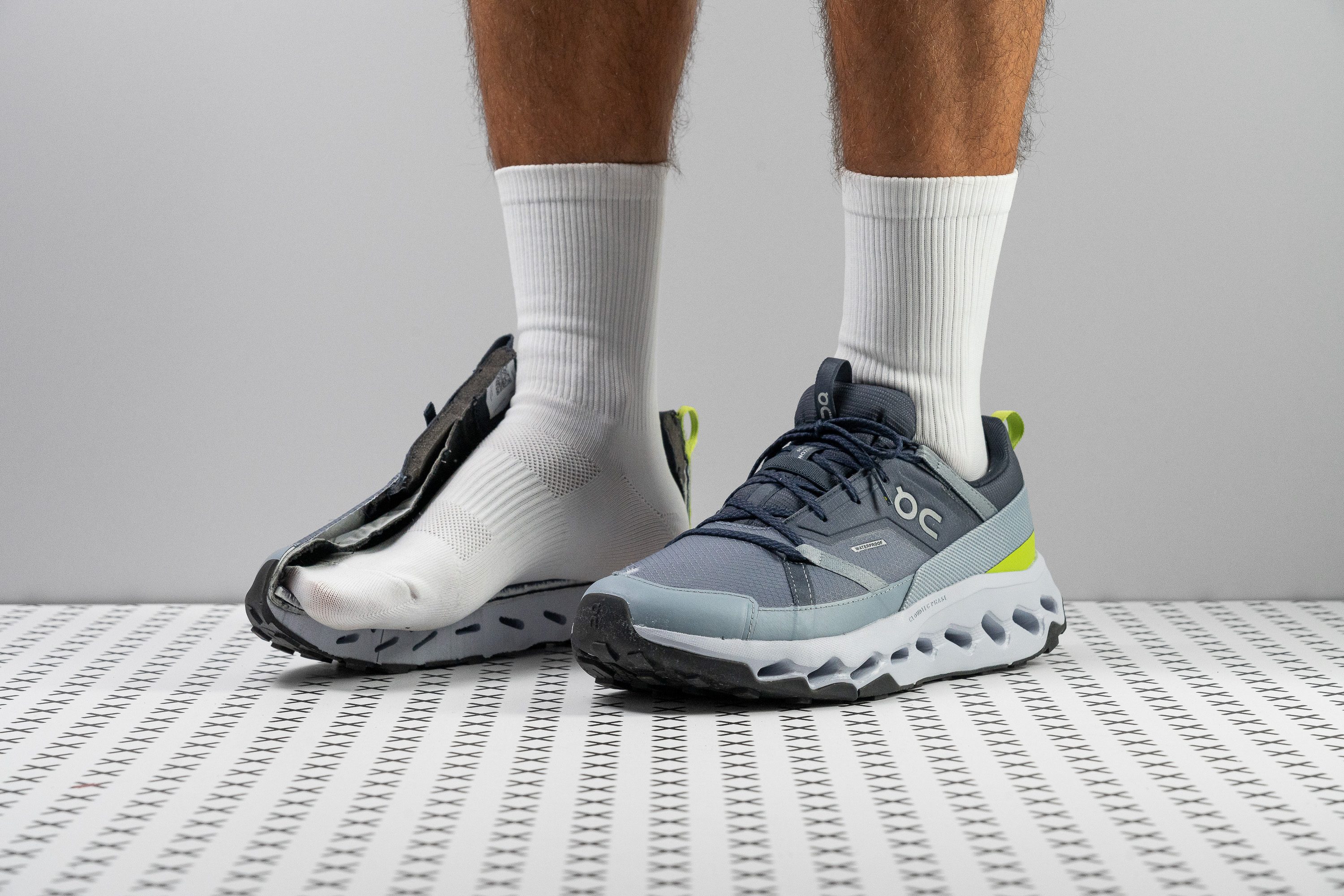




















































What makes it the best?
We instantly enjoyed the suppleness and lightness of the On Cloudhorizon Waterproof during our trail adventures, making it our top city-to-trail hiking shoe for flat feet. Our lab tests confirm its exceptional impact protection and easygoing nature while offering support to stabilize the ride.
We measured the stack with our caliper, and it emerged a sky-high 39.4/29.2 mm, erasing the harshness of the ground. Its CloudTec cushioning has some pleasant spring to it, while the heel effectively reduces the forces of each touchdown. In our shock absorption test, its 126 SA proves it’s 21.2% more protective than average.
To boost well-planted footing, Cloudhorizon Waterproof broadens its midsole to 116.3/89.1 mm. The extra width secures our balance, keeping us centered in the platform.
We found the shoe light for all the support it brings. Our scales reveal it’s only 12.0 oz (339g), making it 10.8% lighter than the average hiking shoe. It’s effortless to bring around even during long hours on foot.
However, we advise reserving this pair for easier hikes. It’s hard to trust its shallow 2.3 mm lugs in more challenging terrain.
Pros
- Effective waterproofing
- Abundant cushioning and impact protection
- Lively and responsive ride
- Amazingly light for its stack and waterproofing
- Great as a city-to-trail shoe
- Good stability for moderate terrain
- Comfortable in-shoe feel
- True to size and fit
Cons
- Not for serious hiking
- Lacks durabiity for the price
The effect of footwear on arches
Hikers who have flat feet have flat or fallen arches. These arches help stiffen the foot while walking but, when they are low or flat, there’s not enough stiffness. Because of this, footwear for flat-footed people is usually very stable and supportive. These are much-needed features because the arches can’t provide enough support on their own.
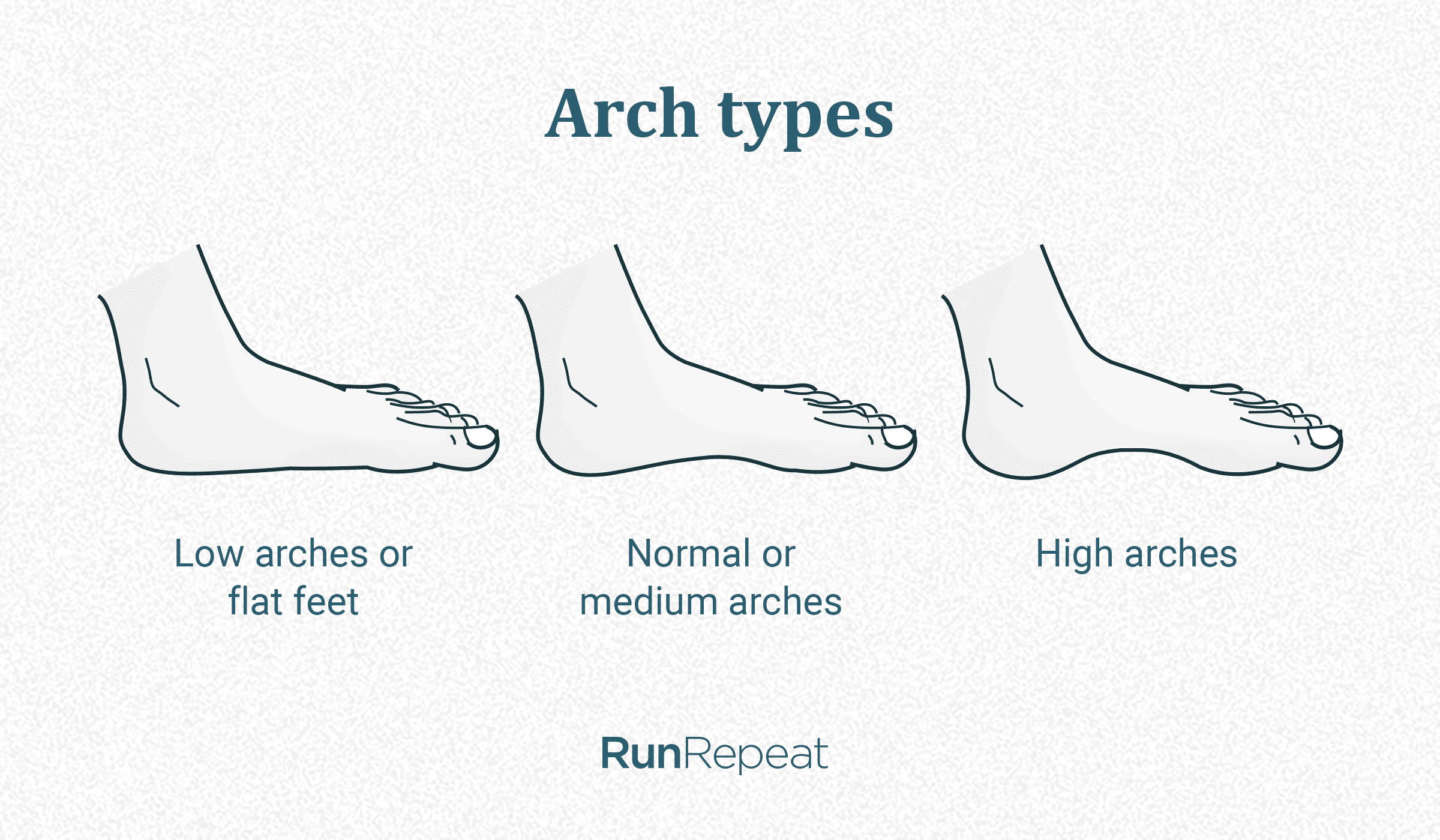
Every foot has 3 arches, and when we talk about flat feet, we refer to the medial longitudinal arches.
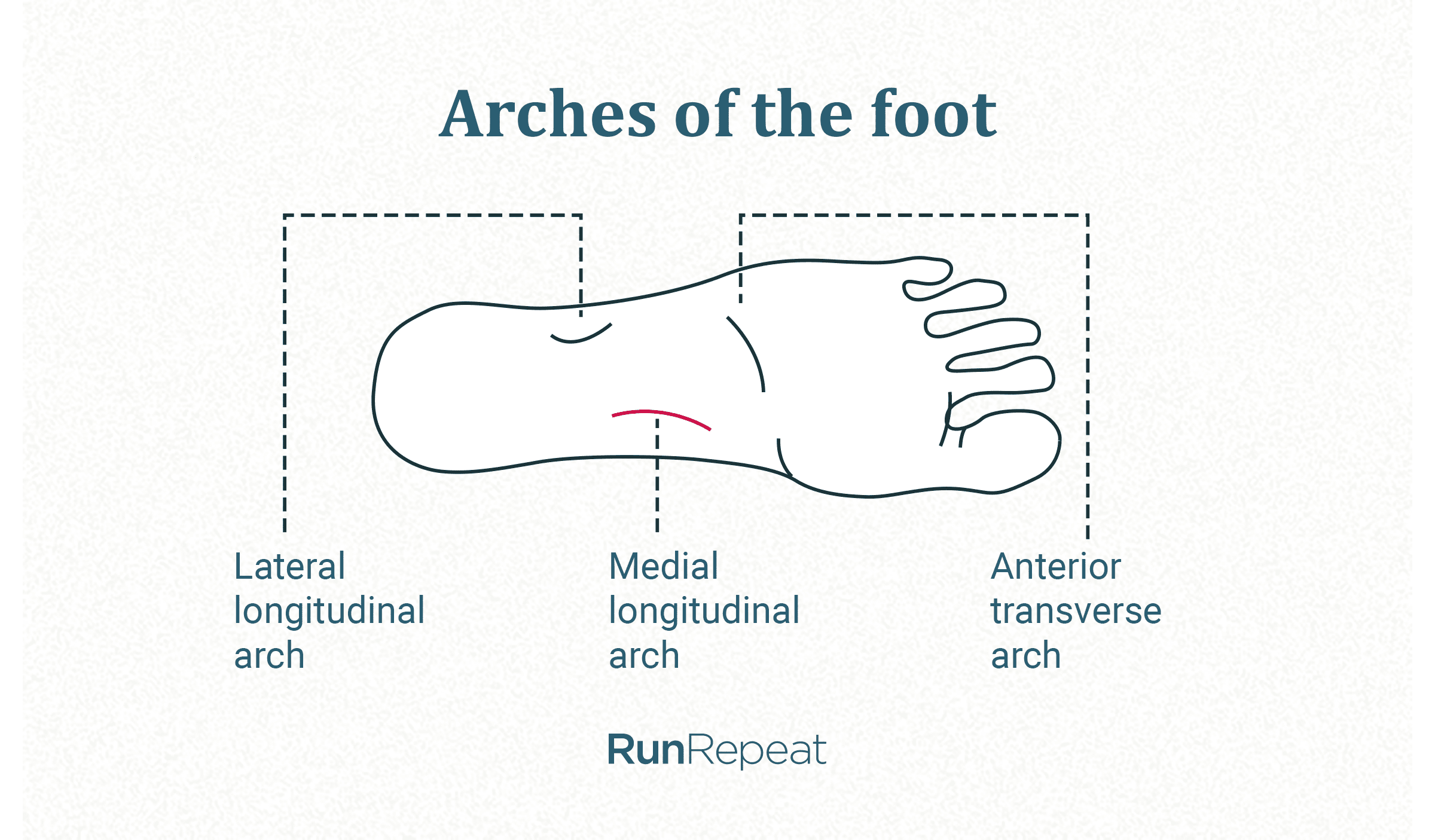
Studies have shown that people who grow up barefoot or wearing minimalist footwear have stronger foot muscles and higher and stiffer arches. It is said that it’s the modern footwear that makes our feet flat. And this is why there are opposing opinions about minimalist footwear.
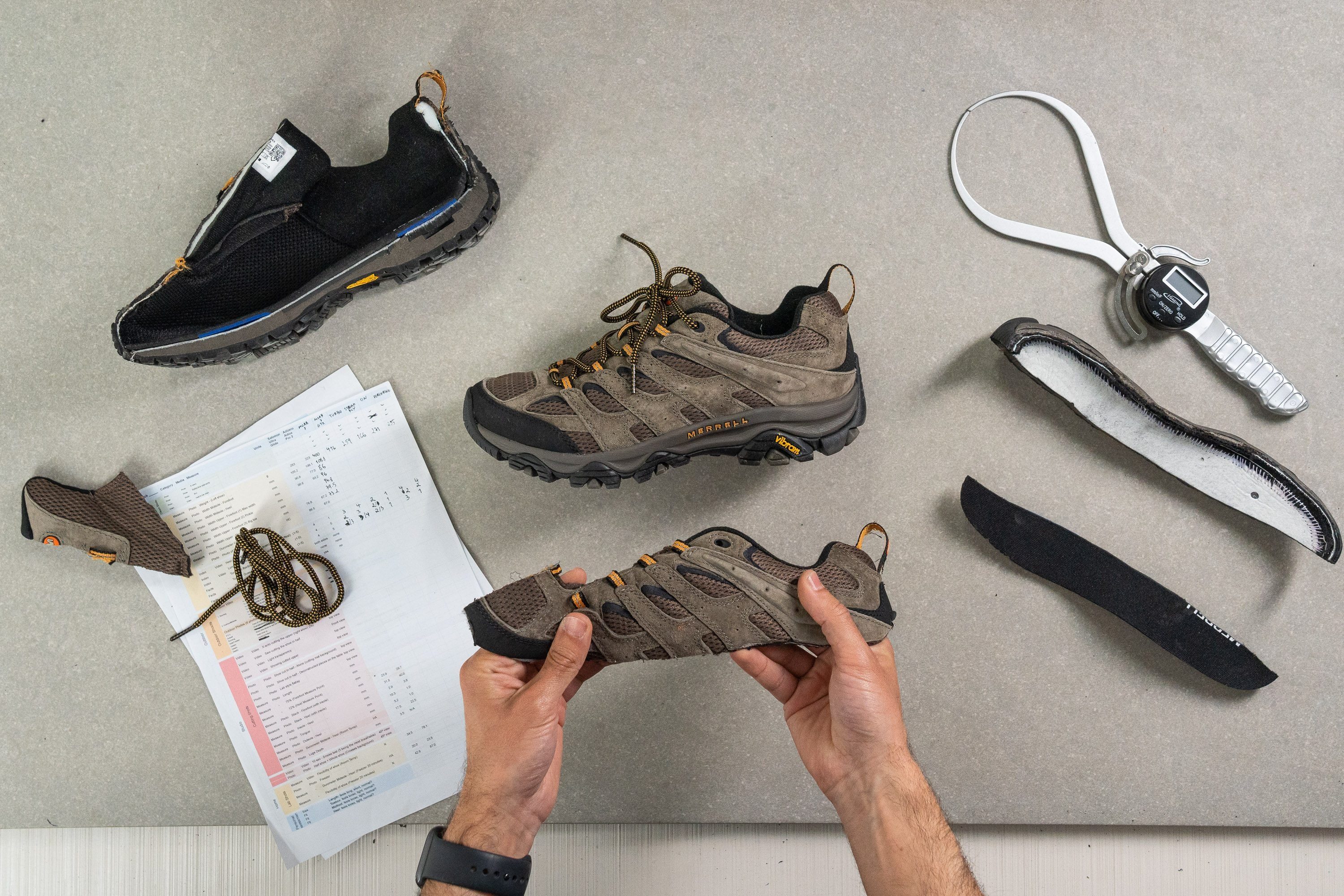
3 features to look for in hiking shoes for flat feet
Given that fallen or flat arches need all the support they can get, these features actually allow the hiking shoes for flat feet to be stable and supportive:
- Midsoles that are not too soft. In our experience, that means getting 20 or more on the shore A durometer.
- Stiff heel counters lock the heels in place. We assess the stiffness in our lab and suggest scores of 3,4, or 5 out of 5 for flat-footed hikers.
- Rigid hiking shoes or shoes that are not easy to twist. When we assess torsional rigidity in our lab, we assign ratings on a 1-5 scale. For flat feet, we recommend shoes that got a torsional-rigidity score of 3, 4, or 5 out of 5.
As always (when talking about hiking), you should find hiking shoes with adequate grip for the hikes you have in mind.
Now, we will explain all of these features in greater detail.
Softness of hiking shoes for flat feet
Softness is often directly correlated with comfort. However, softness levels are not the same for all footwear categories.
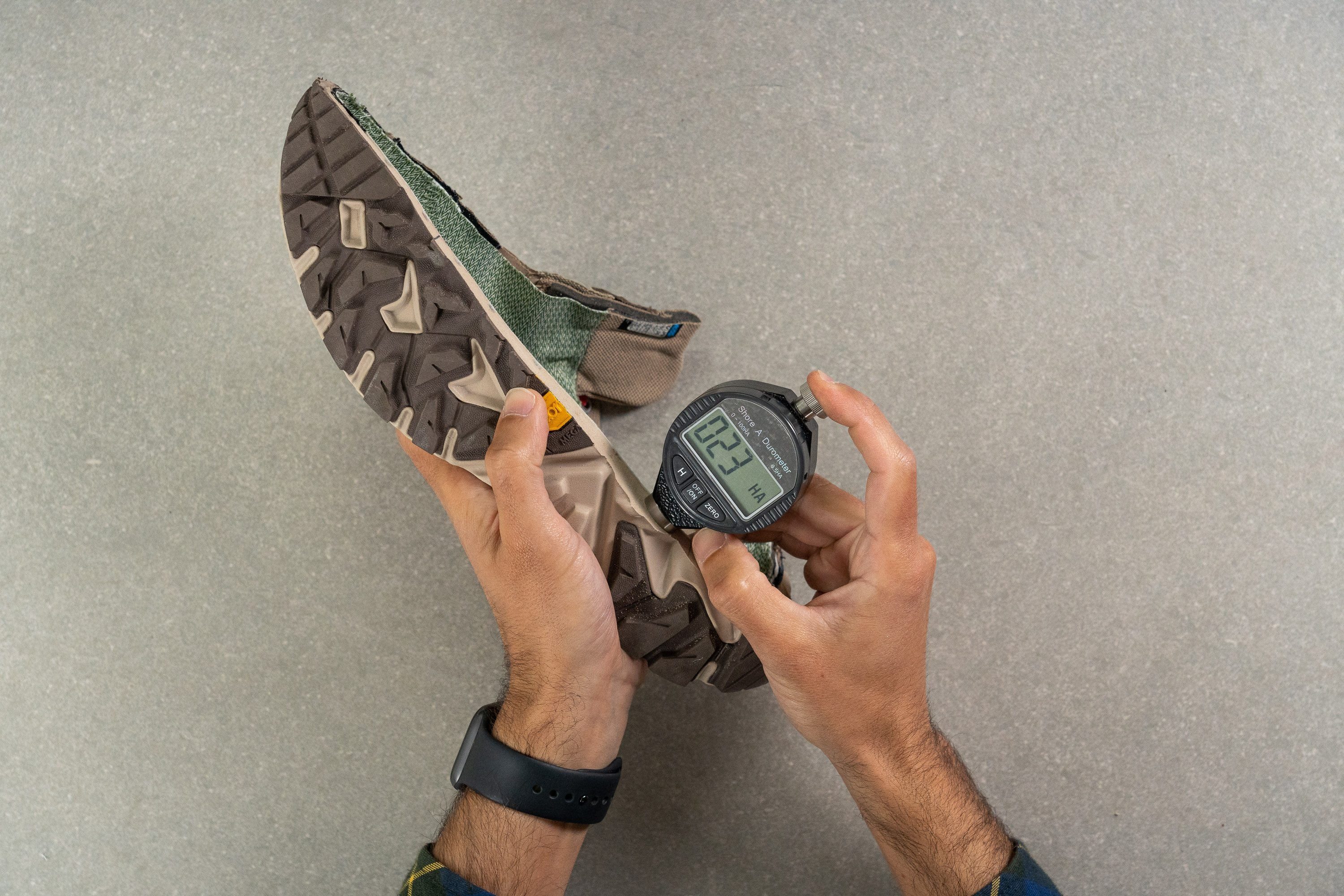
Running shoes are usually softer than hiking shoes. Here are a few numbers from our lab (noted down at the moment of writing this guide) to get the idea:
- Average softness of road running shoes: 21.2
- Average softness of trail running shoes: 22.8
- Average softness of hiking shoes: 27.6
- Average softness of hiking boots: 27.8
If you have flat feet, we recommend somewhat firmer platforms in hiking shoes, because it’s best to avoid any unnecessary wobbling. Based on our experience in the mountains and our lab tests, we recommend midsoles that scored at least 20 HA on the durometer.
Shock absorption of hiking shoes for flat feet
Shock absorption trumps softness, and here's why: imagine the platform being soft just the way you like it but not good at attenuating the impact at all! This would result in premature foot fatigue and maybe even foot pain.
Testing the shock absorption of hiking shoes for flat feet
How to avoid it? Look at both numbers. It's important to have a midsole with good shock absorption because dealing with flat feet might be enough already; why put more stress on the feet? Let the midsole do as much as possible.
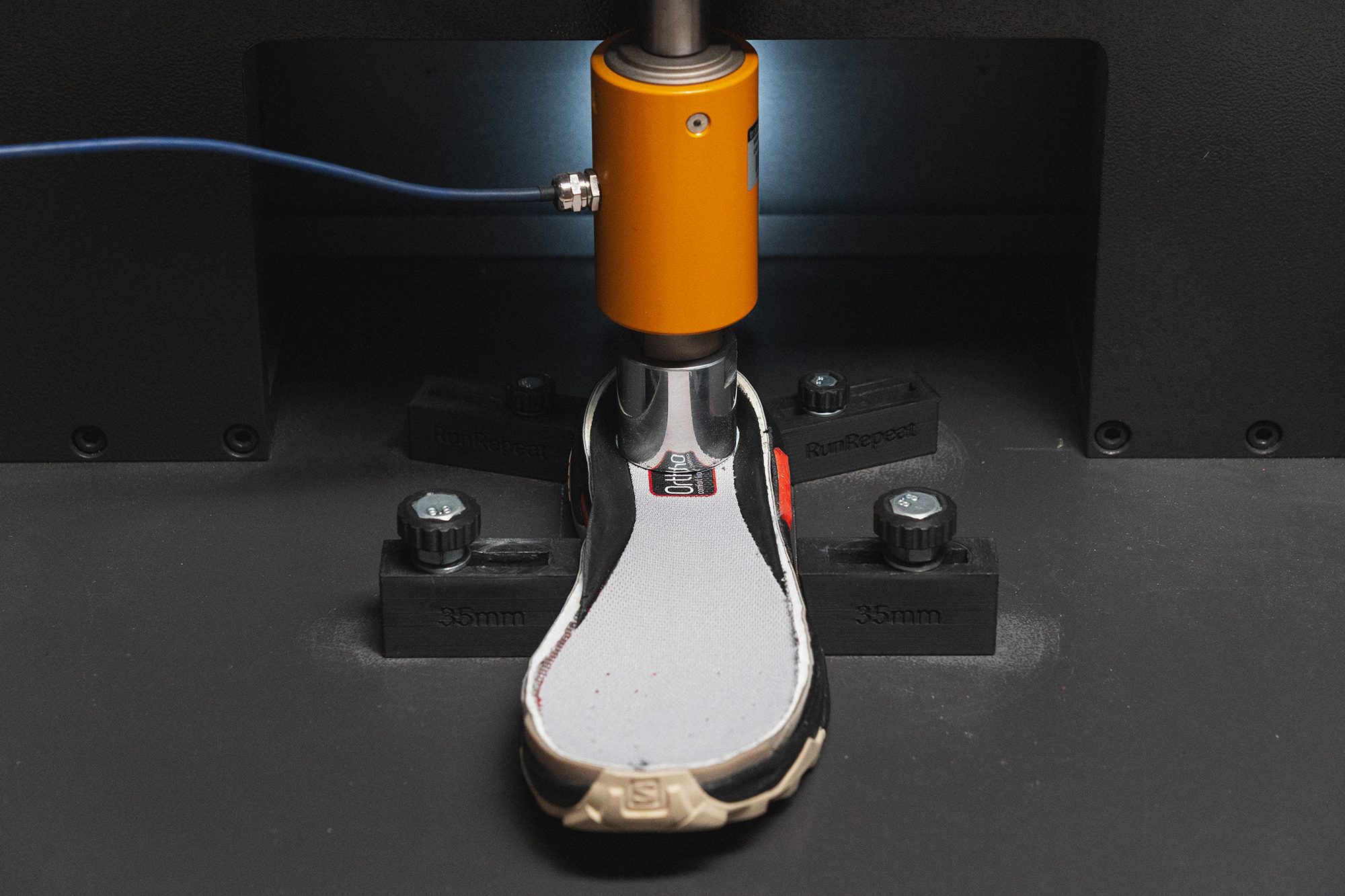
The result of this test is given in SA. The higher it is, the better, although anything in the 100-115 SA range is considered moderate, and above 115 SA is considered high.
Stiffness of heel counters in hiking shoes for flat feet
Some runners land on the forefoot, not on the heel. But, in hiking, in most cases, we land on the heel. Looking for more support for the heel means looking for a stiff heel counter.
This heel counter scored 3/5 in our lab (1/5 is the most flexible, 5/5 very rigid)
Heel counters that are sock-like offer no support. We suggest those that scored at least 3/5 on our assessment.
Very stiff heel counter (we rated its stiffness with 5/5 in our lab)
If you want to figure it out on your own, try pushing and squeezing the heel area. Look for those heel counters that resist your pushes and squeezes the most.
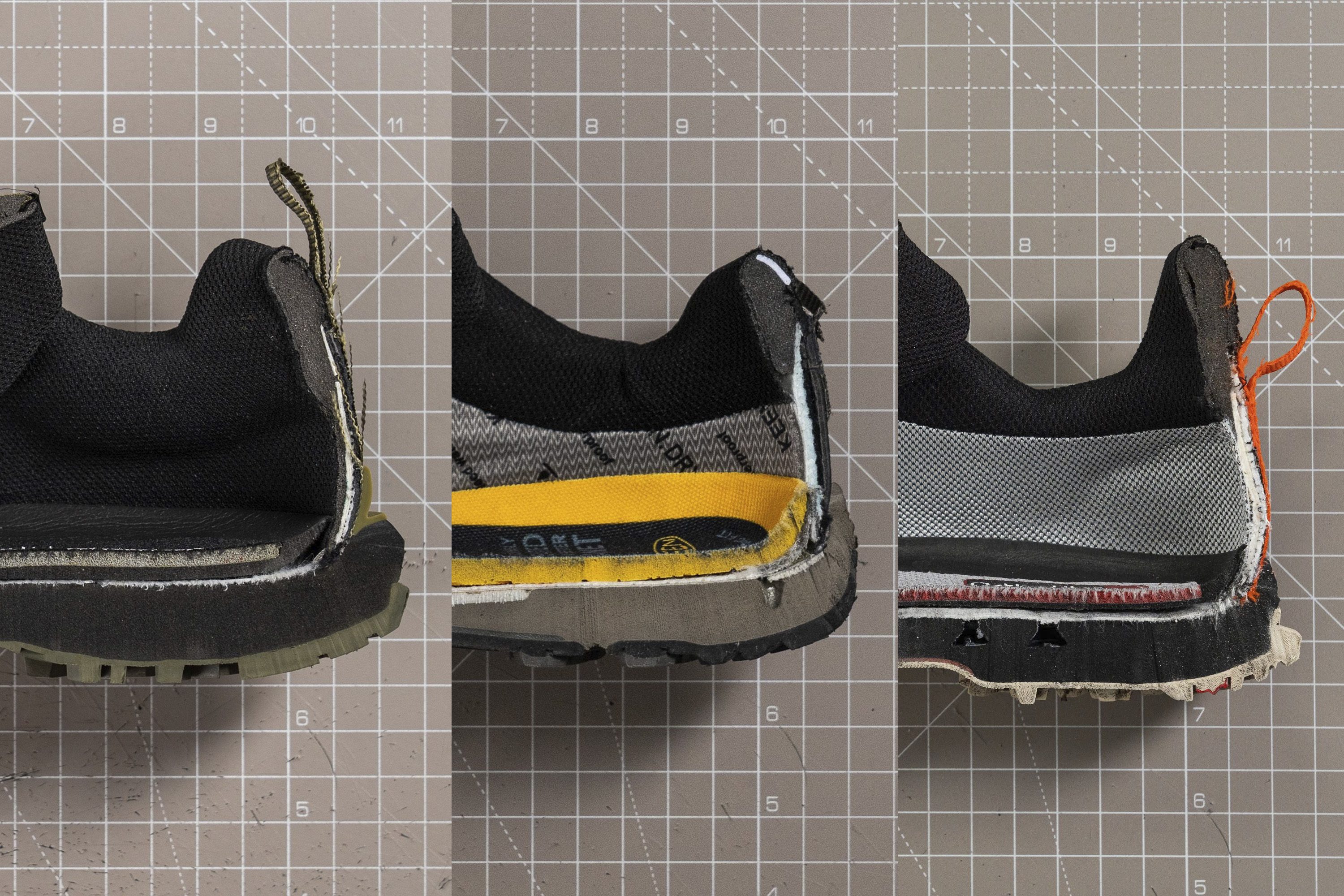
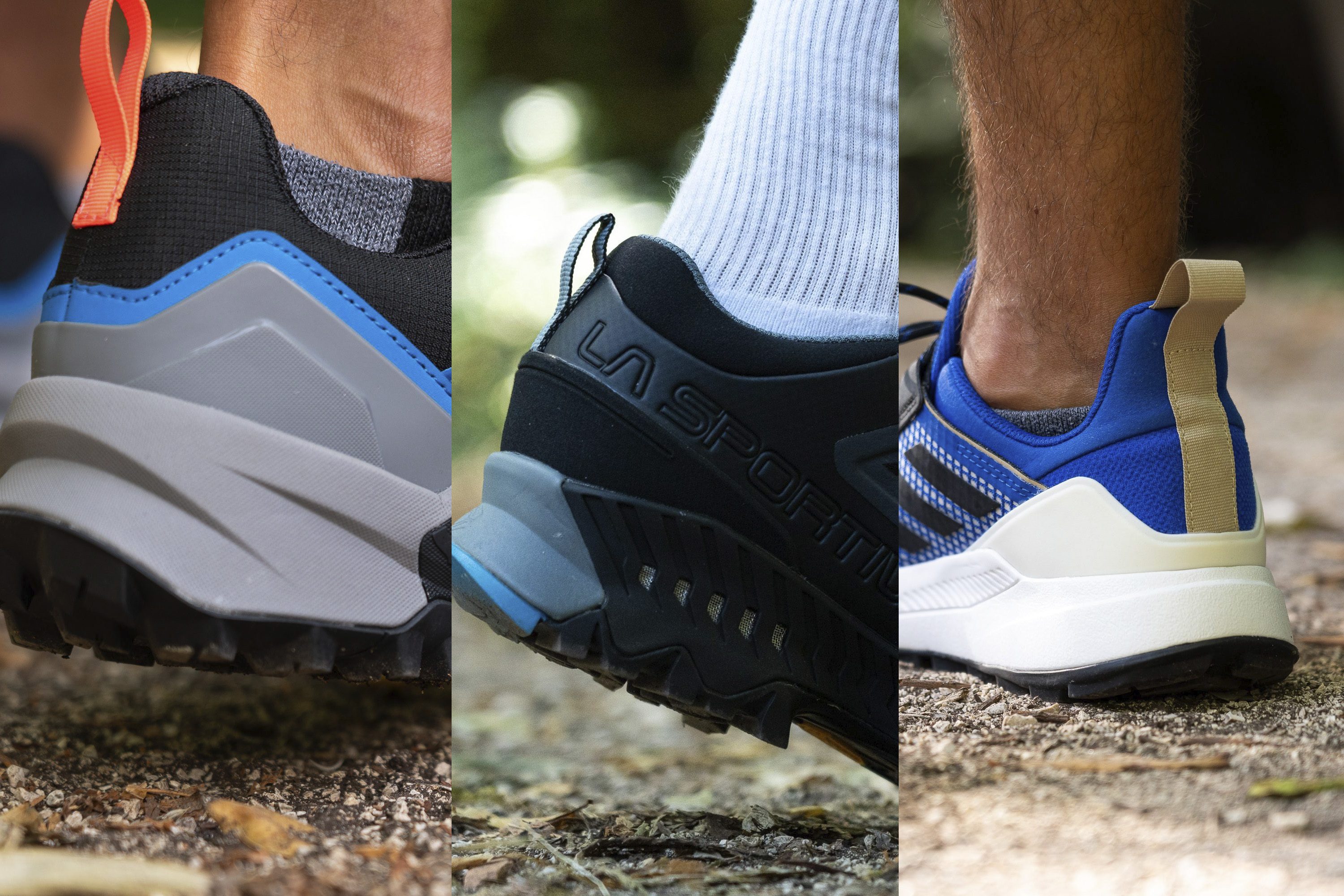
How rigid should hiking shoes for flat feet be
In our lab, we test the longitudinal stiffness/flexibility of hiking shoes and torsional rigidity. Longitudinal stiffness tells us how much force is needed to bend the shoe, while torsional rigidity tells us how easy or difficult it is to twist the shoe.
This hiking shoe got a 2/5 on our torsional rigidity assessment, which makes it flexible
This hiking shoe was rated 5/5 on our torsional rigidity assessment, which makes it very rigid
For hikers with flat feet, we recommend rigid to very rigid hiking shoes. In numbers, it’s the hiking shoes that we assigned a rating of 3/5, 4/5, or 5/5 on our assessment.
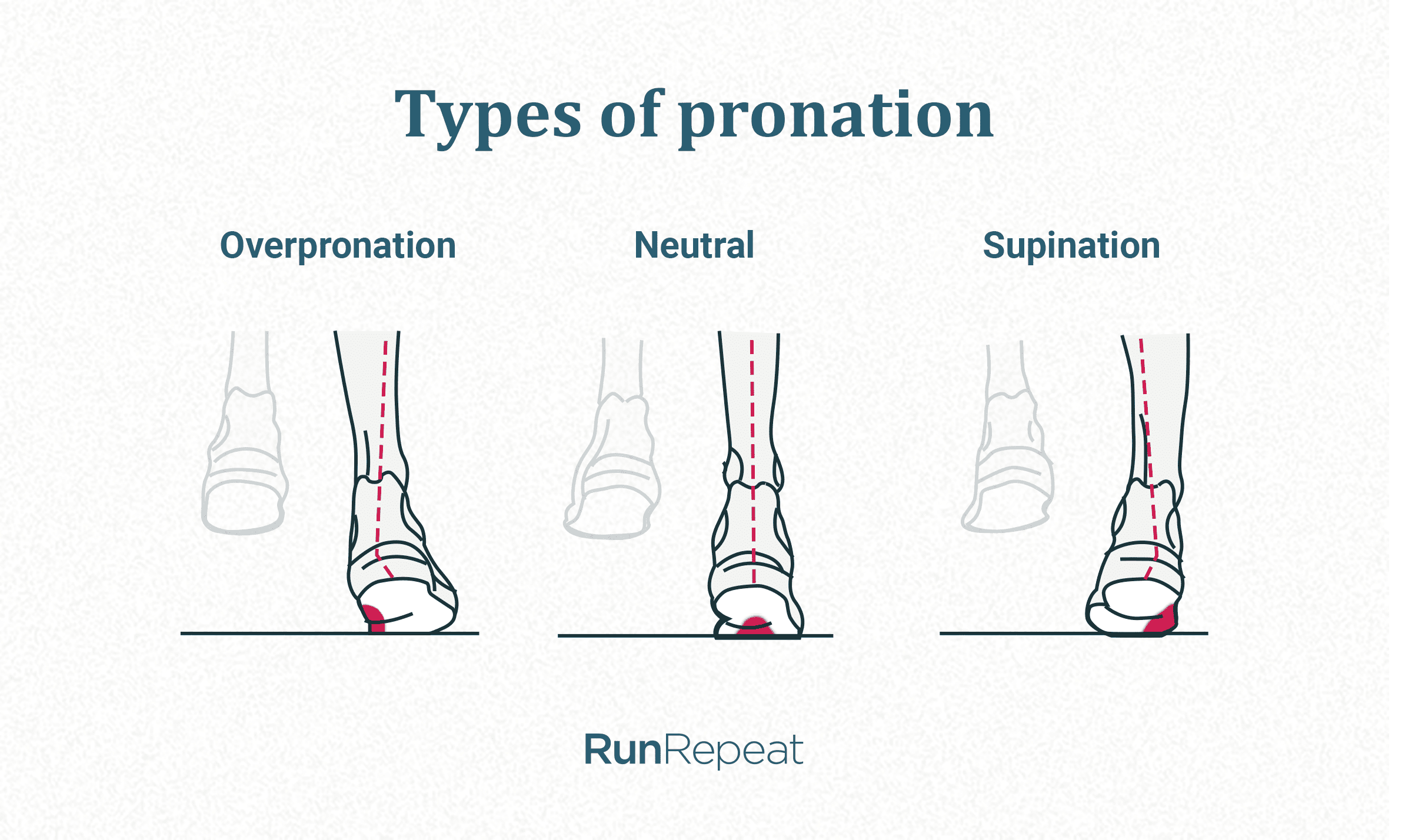
The idea behind this rigidity is to somewhat limit the unwanted foot movement. Hikers with flat feet often overpronate, so they already have excessive rolling of the ankle inward. Hiking in rigid platforms helps with that by offering stability and support, especially on uneven terrain.
These rigid hiking shoes can be quite flexible and quite stiff, as you can see in the table below:
Finding superb grip based on the terrain
There are many different types of terrain and we usually group them in 3 very broad categories which have some overlap, of course:
- Light terrain. Usually flat, found on easy hikes. Hikes on light terrain can be covered in shoes with shallow lugs (2-3 mm), or even trail running shoes.
- Moderate terrain. Uphills and downhills on everything but technical terrain. It’s best to use versatile hiking shoes with average-deep lugs that have different shapes and orientation.
- Technical terrain is saved for the most protective shoes with thick toe bumpers and firmer and stiffer platforms. Hikers need all the protection and stability they can get when covering sharp rocks, mud, demanding single tracks covered with debris, etc. We usually recommend deep lugs for technical terrain (4 mm and deeper).
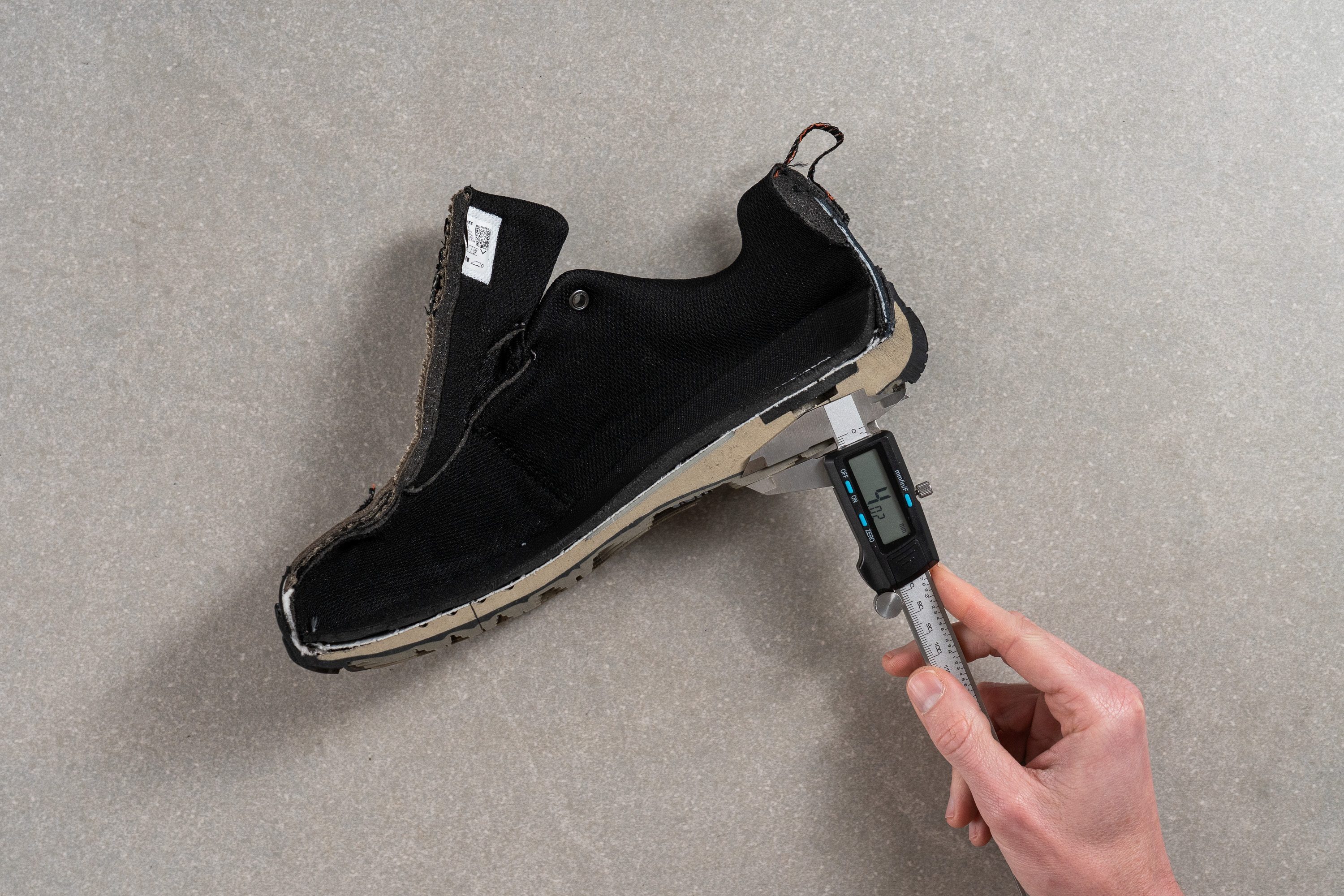
When deciding on the type of terrain and use, we also take into account the shape of the lugs, their orientation, how far apart they are one from the other, the design of the shoe, how stiff the platform is, whether the heel is chunky, etc.
Wide platforms bring even more stability!
Some hiking shoes have very wide midsoles and can feel bottom-heavy, while others have narrow platforms but might feel unstable. Nevertheless, wider platforms bring more stability, so if you’re looking for that extra touch, you’re in the right place.
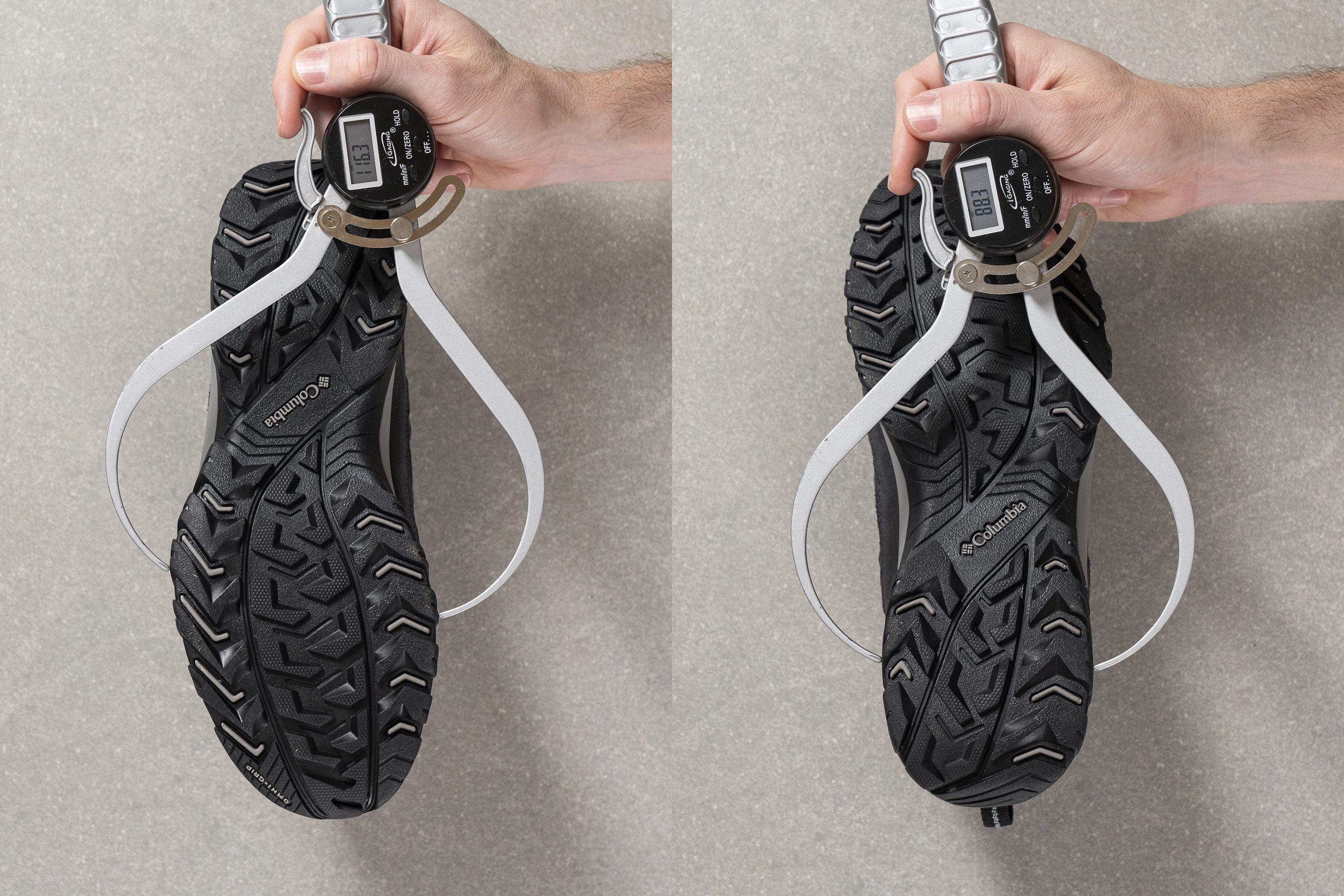
Minimalist hiking shoes for flat feet: the controversy
There are many pros and cons for minimalist footwear. Whether you should use minimalist hiking shoes depends on your current condition and your goals. However, it is confusing to learn that some flat-footed hikers dealt with pain by wearing minimalist hiking shoes, while others got hurt even more in those and went for very stiff and very cushioned options.
Minimalist hiking shoes are low to the ground, have a low or zero drop, often no extra protective details like a chunky toe bumper, have no stability features, and they are very flexible
|
Minimalist footwear can strengthen the foot muscles and make movement less painful. However, it depends on the exact foot condition and how much someone can benefit from such footwear, if at all. This is especially true because the transition should be very gradual, and many overlook that, which ends in discomfort, pain, or even injury. |
Who minimalist/barefoot hiking shoes are good for
- People who grew up wearing such footwear. Their feet and legs are already adjusted to the minimal or no support, minimal or no cushioning, zero drop, etc.
- Strengthening foot muscles. However, hikers who decide to do this usually come from the conventional footwear world, which means they should ease into it. A gradual transition is the way to go.
- Hikers who want more ground feel.
- Hikers who want to experience as natural movement as possible due to the highly flexible and non-cushioned platform.
|
Another hiking shoe feature that is often overlooked is heel to toe drop. Minimalist and barefoot hiking shoes have zero drop or low drop, while an average hiking shoe has a drop of 11.1 mm. A 10 mm drop is said to be standard, but there’s no written rule about it. This is important because zero-drop shoes utilize the foot muscles the most. The higher the drop, the higher leg muscles are utilized, so in hiking shoes with 10mm drop, muscles around the hips are doing a lot of work. This comes in handy for hikers dealing with an injury, when foot muscles should be used less, shoes with a higher drop can be worn. And vice versa, we can wear low-drop hiking shoes when we want to strengthen foot muscles or when we want to use our thighs and hip muscles less. |
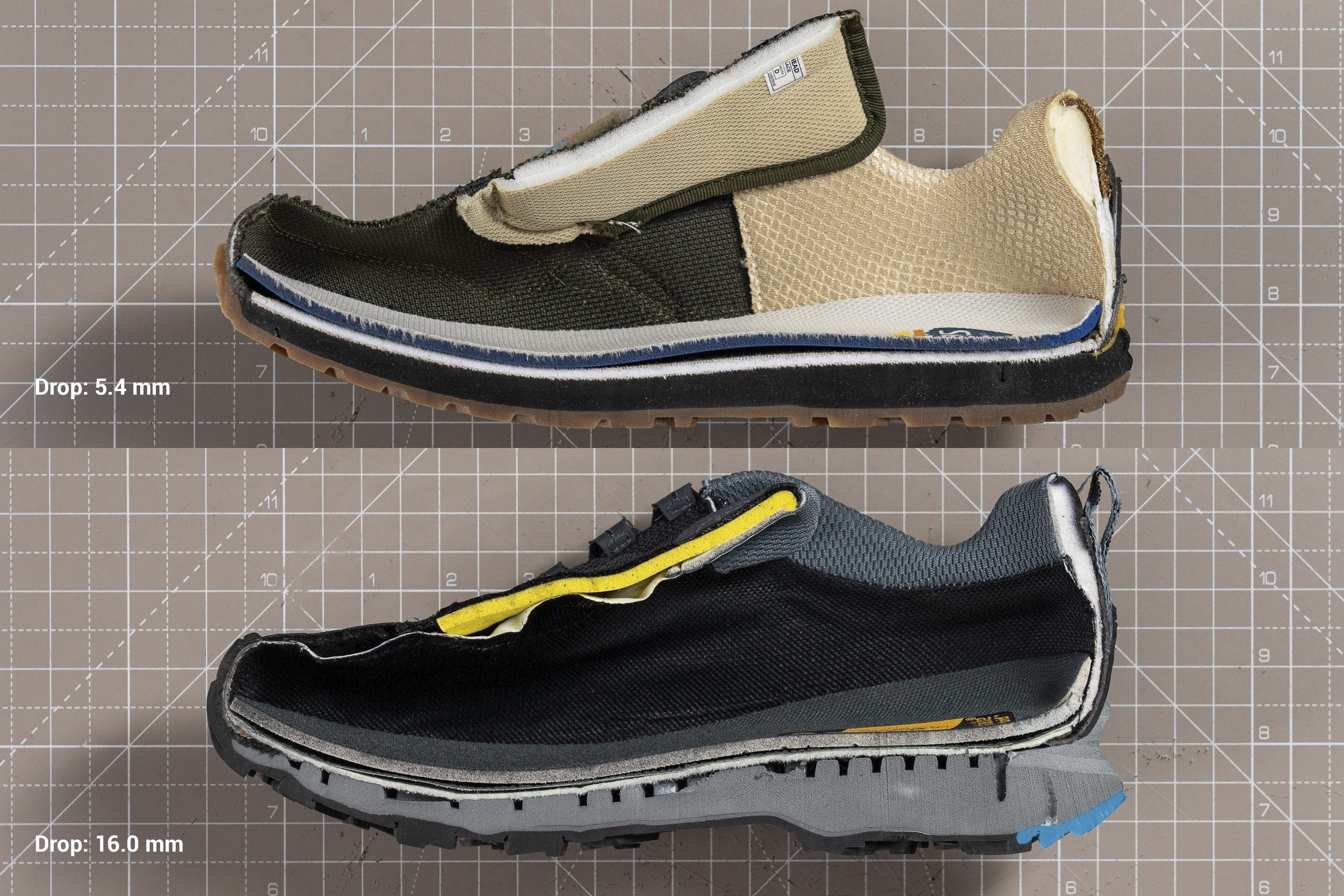
We actually wrote an in-depth guide on heel to toe drop in case you want to learn more about it.
Who cushioned and supportive hiking shoes are good for:
- Hikers with flat feet and plantar fasciitis, and hikers who excessively overpronate or supinate, especially if they are experiencing discomfort on longer hikes, which is when they feet need more support.
- Beginner hikers who grew up wearing conventional footwear (high drop, cushioned, etc.) and who want to explore trails of different difficulty levels (light, moderate, and especially technical).
- Hikers who are doing rehabilitation due to an injury and potentially a cushioned platform or a high-drop platform is helping them at the moment.
Minimalist footwear is too risky? Do the exercises!
If you want to improve your movement and strengthen your arches, doing exercises for at least 5 weeks can help.
This study has shown that doing exercises for 30 minutes, 3 times a week, for 6 weeks can improve the navicular drop height and longitudinal arch angle and the cosmetic appearance of the foot. These exercises included foot shortening exercises, stretching, and gluteal muscle strengthening, in addition to the widely known active dorsiflexion and plantarflexion.
More studies (as seen in this systematic review) have shown that exercises can help improve the medial longitudinal arch.

